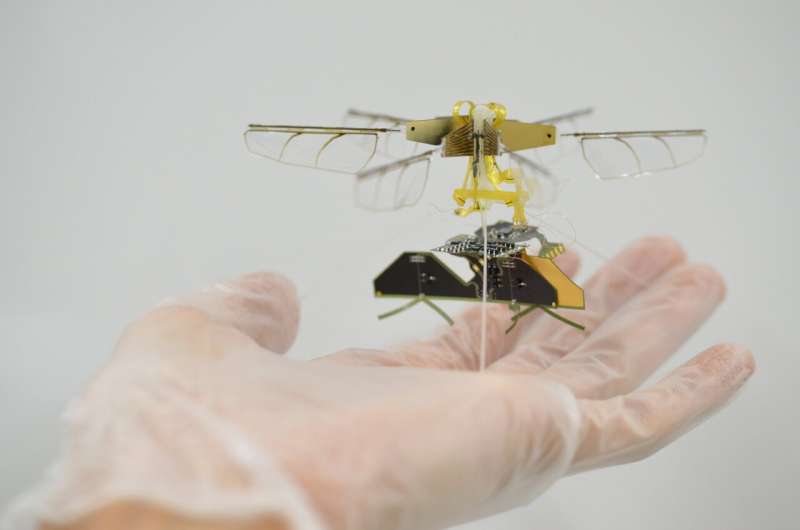December 15, 2021 feature
A new untethered and insect-sized aerial vehicle

Researchers at Toyota Central R&D Labs have recently created an insect-scale aerial robot with flapping wings, powered using wireless radiofrequency technology. This robot, presented in a paper published in Nature Electronics, is based on a radiofrequency power receiver with a remarkable power-to-weight density of 4,900 W kg-1.
"Small drones typically have a very limited operating time due to their power source," Takashi Ozaki, one of the researchers who carried out the study, told TechXplore. "The purpose of our recent research was to overcome this limitation. Currently, no-contact power supply using electromagnetic waves has been put to practical use in various products, but it was unknown how far it could be applied to small flying robots."
The main objective of the recent study by Ozaki and his colleagues was to power an insect-size flying robot using no-contact, wireless charging technology. The robot created by the researchers is essentially comprised of a flapping, piezoelectric actuator that is powered through a 5 GHz dipole antenna.
"One of our robot's key features is a highly efficient flapping actuation, which is achieved using high-power single-crystal piezoelectric material and a low-loss layout with two wings facing each other, like clapping hands," Ozaki said. "This design enables a power-to-weight efficiency comparable to that of live insects."
A key challenge encountered by engineers who are trying to create miniature size robots is the thermal runaway caused by power losses. To overcome this challenge, Ozaki and his colleagues optimized their robot's circuit design, ensuring that components that generate heat were not placed closely together or next to each other.
In addition, the researchers used a radiofrequency power receiver with a power-to-weight density that is significantly higher than that of off-the-shelf lithium polymer batteries with a similar mass. This significantly improved the robot's efficiency and operating time.
"I think that our most important finding is that a sub-gram circuit can receive and handle high power of over 1 W at a distance via an RF wave," Ozaki said. "This suggests that not only flying robots but also various other applications that require large power in a small size can be realized without batteries."
To evaluate the effectiveness of their design, Ozaki and his colleagues carried out a series of experiments. In these tests, they were able to make the insect-size robot take off seamlessly and without the need for batteries or wires.
The robot created by this team of researchers weighs only 1.8g, thus it is over 25 times lighter than other radiofrequency-powered micro-sized vehicles developed in the past. In the future, it could thus prove to be highly valuable for conducting complex missions that entail entering cracks, pipes or other highly confined spaces.
"In this paper, we have successfully demonstrated takeoff," Ozaki said. "The next step is to combine this power supply technology with attitude control to make this robot hover and move freely in the air. We believe that this is technically possible, as we have already succeeded in controlling the robot's attitude with wired power."
More information: A wireless radiofrequency-powered insect-scale flapping-wing aerial vehicle. Nature Electronics(2021). DOI: 10.1038/s41928-021-00669-8.
Flight control of flapping-wing robot with three paired direct-driven piezoelectric actuators, IFAC-PapersOnLine, DOI: 10.1016/j.ifacol.2020.12.2408.
© 2021 Science X Network



















